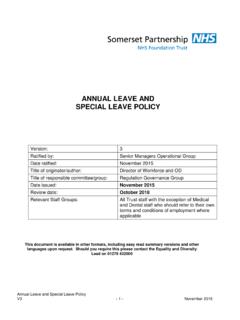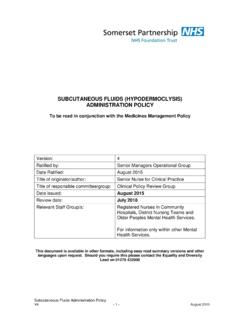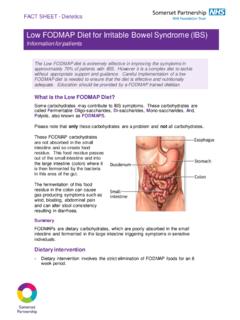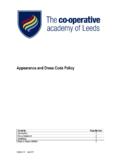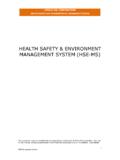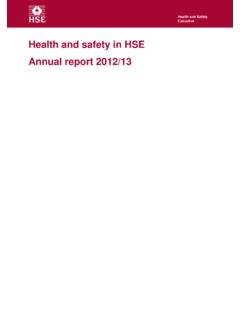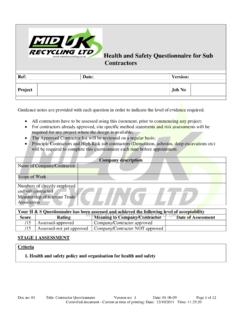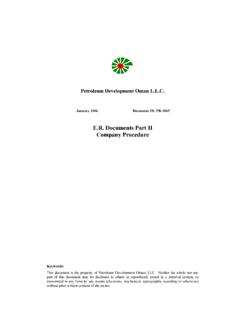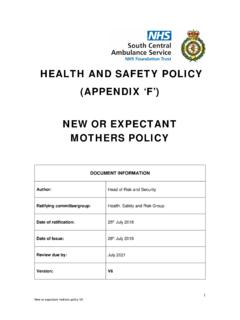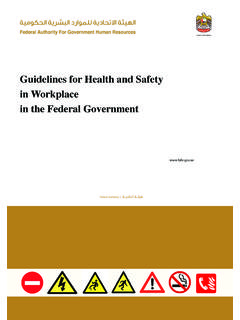Transcription of LONE WORKING POLICY - sompar.nhs.uk
1 lone WORKING POLICY V4 - 1 - August 2016 lone WORKING POLICY Version: 4 Date issued: August 2016 Review date: July 2019 POLICY Scope This POLICY is applicable to any employee, volunteer or contractor who may be considered a lone worker whilst undertaking work for the Trust. POLICY Summary This document sets out an overarching framework to guide and inform the development of local lone WORKING procedures across all Trust services and including those WORKING alone in the community and in Trust buildings. It provides a robust framework to ensure a consistent approach across the whole organisation and supports the Trust s statutory duties. This POLICY aims to alert staff to lone WORKING risks, to identify their responsibilities and offers guidance to manage such risks.
2 The Trust has undertaken a review of its management of lone WORKING which was designed to ensure compliance with its legal obligations. By developing this POLICY the Trust aims to demonstrate its commitment to successful health and safety management. by measuring and reviewing incidents relating to lone WORKING when they do occur and by providing guidance to staff it is hoped to reduce the likelihood of such an incident occurring. This document is available in other formats, including easy read summary versions and other languages upon request. Should you require this please contact the Equality and Diversity lead on 01278 432000 lone WORKING POLICY V4 - 2 - August 2016 DOCUMENT CONTROL Reference AS//Aug16/LWP Version 4 Status Final Author Head of Corporate Business Amendments Extensively revised following a Health and Safety Self-Assessment in 2015, the findings of the CQC Inspection Report and the lone WORKING Group questionnaire sent to managers.
3 Committee/Group Consulted: Executive Management Team, Operational Management Meeting, Health, Safety and Security Management Group. Monitoring arrangements and indicators: Local procedures to be monitored and reviewed regularly by managers; POLICY to be monitored through Health, Safety and Security Management Group. Training/resource implications: Please refer to Trust Training Matrix for further information. Approving body and date Health, Safety, Security, Estates and Facilities Group Date: July 2016 Formal Impact Assessment Impact Part 1 Date: August 2016 Ratification Body and date Senior Managers Operational Group Date: August 2016 Date of issue August 2016 Review date July 2019 Contact for review Head of Corporate Business Lead Director Director of Strategy and Corporate Affairs CONTRIBUTION LIST Key individuals involved in developing the document Name Designation or Group Members JMSCC Members Regulation Governance Group Members Senior Managers Operational Group Members Operational Management Meeting Members Health, Safety and Security Management Group Steve Parker Health and Safety Competent Advisor Tracey Edwards LSMS lone WORKING POLICY V4 - 3 - August 2016 REFERENCES AND ASSOCIATED DOCUMENTS References Health and Safety at Work etc.
4 Act 1974 Health and Safety Executive - WORKING Alone in Safety Management of Health and Safety at Work Regulations 1999 Not Alone A Guide for the Better Protection of lone Worker in the NHS March 2005 Reporting of Injuries, Diseases and Dangerous Occurrences Regulations 1995 UNISON - WORKING Alone: A Health and Safety Workplace (Health and Safety and Welfare) Regulations 1992 Cross reference to other procedural documents Clinical Assessment & Management of Risk to Self and Others POLICY Health and Safety POLICY Agile WORKING POLICY ; Information Governance POLICY Learning Development and Mandatory Training POLICY Prevention and Management of Violence and Aggression POLICY Risk Management POLICY and Procedure Risk Management Strategy Security POLICY Serious Incidents Requiring Investigations (SIRI) POLICY All current policies and procedures are accessible in the POLICY section of the public website (on the home page, click on Policies and Procedures ).
5 Trust Guidance is accessible to staff on the Trust Intranet. lone WORKING POLICY V4 - 4 - August 2016 CONTENTS Section Summary of Section Page Doc Document Control 2 Refs References and Associated Documents 3 Cont Contents 4 1 Introduction 5 2 Duties 5 3 Definitions 8 4 lone WORKING 9 5 Local Arrangements for lone WORKING 10 6 Communication 12 7 Buddy Systems 12 8 Technology 13 9 Supervision 15 10 What to do if there a Genuine Concern 15 11 Immediate Support Following an Incident 16 12 Involving the Police 16 13 Monitoring Compliance and Effectiveness 16 14 Relevant Care Quality Commission (CQC) Registration Standards 17 15 Appendices 17 Appendix A Practical Suggestions for the Development of Local lone Worker Procedures 18 Appendix B Guidance Notes on lone WORKING 22 Appendix C Personal Details 26 lone WORKING POLICY V4 - 5 - August 2016 1.
6 INTRODUCTION The Trust recognises some staff work by themselves for significant periods of time in the community without close or direct supervision, in isolated work areas and often out of normal WORKING hours. The purpose of this POLICY is to provide an overarching framework to guide the development of local procedures to protect staff, so far as is reasonably practicable, from the risks of lone WORKING . It would be impractical to address each situation individually. This POLICY has been designed to be as wide ranging as possible but still assist managers to manage the risks of lone WORKING through the development of service-specific local lone WORKING procedures. The Trust acknowledges the effective processes already in place locally to minimise the risks of lone WORKING , this POLICY is designed to support and strengthen those arrangements and to ensure consistency across the organisation.
7 There is a clear imperative to balance the Trust s legal obligations to ensure lone worker safety against avoiding an overly bureaucratic system which would be too onerous to effectively implement. This POLICY takes into account NHS Protect guidance on protecting health staff and the options available to take action against those who abuse or assault them. The Trust recognises its obligations under the Health and Safety at Work Act (1974) and the Management of Health and Safety at Work Regulations (1999) for the health, safety and welfare at work of its staff. These responsibilities apply equally to those staff who work alone. They require the Trust to identify hazards, assess the risks and put local measures in place to avoid or control the risks.
8 This POLICY aims to: increase staff awareness of lone WORKING safety; ensure the risk of WORKING alone is systematically assessed; support the development of local procedures to eliminate risks to staff WORKING alone or to reduce those risks to the lowest practicable level; ensure appropriate training is available to identified lone workers which provides practical advice on safety when WORKING alone; encourage full reporting and recording of incidents relating to lone WORKING ; reduce the number of incidents related to lone WORKING ; ensure the Trust complies with relevant health and safety legislation and current best practice. 2. DUTIES The Chief Executive has overall accountability for the health and safety of staff, visitors, patients and others through effective governance structures to lone WORKING POLICY V4 - 6 - August 2016 ensure policies and procedures are applied fully and consistently.
9 The Director of Strategy and Corporate Affairs has delegated responsibility for ensuring there are procedures in place for lone WORKING . The Director s responsibilities include: coordinating and ensuring the implementation and continued development of the lone WORKING POLICY throughout the Trust; communicating the Trust s commitment to lone WORKING safety; ensuring effective arrangements to identify, evaluate, and manage lone WORKING risks. The Executive Directors and Heads of Division have delegated responsibility for this POLICY and are responsible for ensuring the POLICY is adopted, implemented and promoted in their respective areas. They will ensure in their Directorates there are: suitable local risk assessments on staff who are lone workers; local procedures to protect and ensure the safety of lone workers; arrangements to investigate incidents involving lone workers; arrangements to support lone workers following any incidents.
10 The Head of Corporate Business is responsible for this POLICY and for ensuring appropriate provisions are made to protect lone WORKING staff which complies with relevant health and safety legislation and NHS guidance. The Head has responsibility for raising the profile of lone WORKING across the organisation and provides oversight on the effectiveness of local reporting, assessment and procedures. Managers and Supervisors responsibilities include: ensuring lone workers are made aware of the POLICY and their roles and responsibilities; assessing the need for lone WORKING ; identifying all lone workers in their services; ensuring local lone WORKING risk assessments are completed and uploaded to their local risk registers; escalating any risks to the next level of management and recording this on their risk assessments; regularly reviewing local risks assessments to ensure they remain current and valid; developing local lone WORKING procedures to manage lone WORKING risks; ensuring staff are aware of the local procedures to manage these risks.
